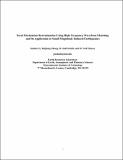| dc.contributor.author | Li, Junlun | |
| dc.contributor.author | Zhang, Haijiang | |
| dc.contributor.author | Kuleli, Huseyin Sadi | |
| dc.contributor.author | Toksoz, M. Nafi | |
| dc.contributor.other | Massachusetts Institute of Technology. Earth Resources Laboratory | en_US |
| dc.date.accessioned | 2012-01-13T19:45:38Z | |
| dc.date.available | 2012-01-13T19:45:38Z | |
| dc.date.issued | 2010 | |
| dc.identifier.uri | http://hdl.handle.net/1721.1/68580 | |
| dc.description.abstract | We present a new method using high frequency full waveform information to determine the
focal mechanisms of small, local earthquakes monitored by a sparse surface network. During the
waveform inversion, we maximize both the phase and amplitude matching between the observed
and modeled waveforms. In addition, we use the polarities of the first P-wave arrivals and the
average S/P amplitude ratios to better constrain the matching. An objective function is constructed
to include all four criteria. An optimized grid search method is used to search over all possible
ranges of source parameters (strike, dip and rake). To speed up the algorithm, a library of Green’s
functions is pre-calculated for each of the moment tensor components and possible earthquake
locations. Optimizations in filtering and cross-correlation are performed to further speed the grid
search algorithm. The new method is tested on a 5-station surface network used for monitoring
induced seismicity at a petroleum field. The synthetic test showed that our method is robust and
efficient to determine the focal mechanism when using only the vertical component of seismograms
in the frequency range of 3 to 9 Hz. The application to dozens of induced seismic events showed
satisfactory waveform matching between modeled and observed seismograms. The majority of the
events have a strike direction parallel with the major NE-SW faults in the region. The normal
faulting mechanism is dominant, which suggests the vertical stress is larger than the horizontal
stress. | en_US |
| dc.description.sponsorship | Massachusetts Institute of Technology. Earth Resources Laboratory | en_US |
| dc.publisher | Massachusetts Institute of Technology. Earth Resources Laboratory | en_US |
| dc.relation.ispartofseries | Earth Resources Laboratory Industry Consortia Annual Report;2010-05 | |
| dc.subject | Microseismic | |
| dc.subject | Inversion | |
| dc.title | Focal Mechanism Determination Using High Frequency Waveform Matching and Its Application to Small Magnitude Induced Earthquakes | en_US |
| dc.type | Technical Report | en_US |
| dc.contributor.mitauthor | Li, Junlun | |
| dc.contributor.mitauthor | Zhang, Haijiang | |
| dc.contributor.mitauthor | Kuleli, Huseyin Sadi | |
| dc.contributor.mitauthor | Toksoz, M. Nafi | |
| dspace.orderedauthors | Li, Junlun; Zhang, Haijiang; Kuleli, Huseyin Sadi; Toksoz, M. Nafi | en_US |
